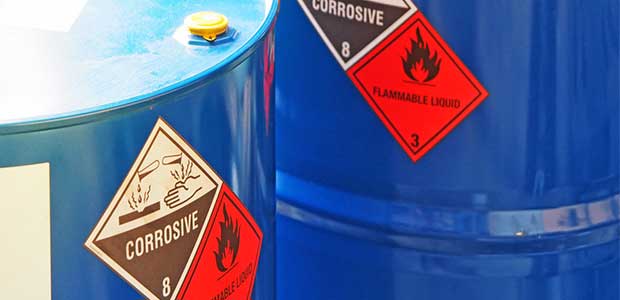
Three Mistakes to Avoid When Storing Flammable Chemicals
Although most facilities or homes will not store chemicals in massive quantities, improperly storing even a small amount of volatile chemicals can cause injury and even worse, death.
- By Julie Lehto
- Aug 25, 2020
The massive explosion in Beirut on Aug. 4, 2020, occurred due to the improper storage of chemicals. About 2,750 tons of ammonium nitrate was stored at the port for six years without preventive measures. The explosion killed 135 people, injured 5,000 people, and will most likely cost around $15 billion in economic losses. Needless to say, properly storing the ammonium nitrate would have saved many lives.
Although most facilities or homes will not store chemicals in massive quantities, improperly storing even a small amount of volatile chemicals can cause injury and even worse, death.
Flammable Versus Combustible
The difference between a flammable and combustible chemical is based on flashpoints, the lowest temperature at which hazardous materials will generate vapors and ignite if exposed to an ignition source.
Flashpoints vary from chemical to chemical. OSHA classifies flashpoints below 100°F (37.8°C) as flammable. Combustible liquids have a flashpoint at or above 100°F (37.8°C) and below 200°F (93.3°C). Flammable and combustible chemicals are present in almost every workplace and home. Knowing how to properly store these chemicals will prevent accidents and injuries.
Avoid Common Mistakes
Most accidents with flammable chemicals happen due to ignorance and complacency. According to a study conducted by the National Fire and Protection Association, flammable or combustible liquid fires result in an estimated 454 civilian deaths, 3,910 civilian injuries, and $1.5 billion in direct property damage per year. Properly storing flammable chemicals is the first step to avoid costly damage and injuries.
Here are three common mistakes to avoid:
Using the Right Storage Container
To save money, some people may opt to store unused chemicals in their original packaging. This may be fine for small amounts of chemicals that will be used in the short term. However, any chemical that will be stored for an extended period should be put in containers designed to hold flammable chemicals.
Use only approved safety containers. The most widely used containers are portable safety cans. They are available in different shapes and capacities. They are made from metal or very low conductivity plastic. These cans have additional features such as spring-mounted spout caps that automatically open when the vapor pressure builds up inside. The spout caps also close automatically when you finish filling or pouring from the safety can, or if the can is dropped.
Labeling the Containers
Regardless of the size of your facility or household, proper labeling of stored chemicals is extremely important. Some chemicals are clear and odorless and can be mistaken for nonhazardous materials. Use a standard label format with the name of the chemical, the date it was stored, and other Material Safety Data Sheets (MSDSs) information included.
Having a Fire Prevention Plan
Accidents will happen and prevention is the best way to prevent a catastrophe. There are two ways to help minimize the possibility of a chemical fire spreading through your facility or home: a spill containment system and fire-resistant storage units.
- Spill containment involves chemicals and other hazardous materials contained within a barrier or drainage system rather than being absorbed at the surface. These systems will prevent the chemical from spreading to a larger area in the event of a spill.
- Fire-resistant storage units have special fire retardant composites in their construction plus heat triggered auto-closing and self-latching doors with vent seals. The cabinets provide a safe and convenient means to store containers of flammable liquids.
Having both of these safety storage precautions will significantly reduce the probability of injury if an accident occurs.
Flammable chemicals are part of daily life. Properly storing them just takes a little bit of planning and effort. Making sure you are up to date with compliance standards will ensure you are storing your chemicals is the safest manner possible.